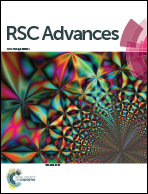A ligation-triggered and protein-assisted fluorescence anisotropy amplification platform for sensitive and selective detection of small molecules in a biological matrix†
Abstract
Effective detection of biomolecules is important for biological research and medical diagnosis. We here propose a ligation-triggered and protein-assisted fluorescence anisotropy amplification platform for sensitive and selective detection of small biomolecules in a complex biological matrix. In the proposed method, in the presence of target small molecules, FAM-labeled DNA 1 and biotin-labeled DNA2 were ligated to produce an integrated DNA. As a result, taking advantage of the extraordinary strong interaction between biotin and streptavidin, we employed a novel mass amplification strategy for sensitive detection of small molecules through fluorescence anisotropy. The method could detect ATP from 0.05 to 1 μM, with a detection limit of 41 nM, and detect NAD+ from 0.01 to 1 μM, with a detection limit of 6.7 nM. Furthermore, ligase-specific dependence of different cofactors provides good selectivity for the detection platform. As a result, the new platform has a broad spectrum of applications both in bioanalysis and biomedical fields.



 Please wait while we load your content...
Please wait while we load your content...